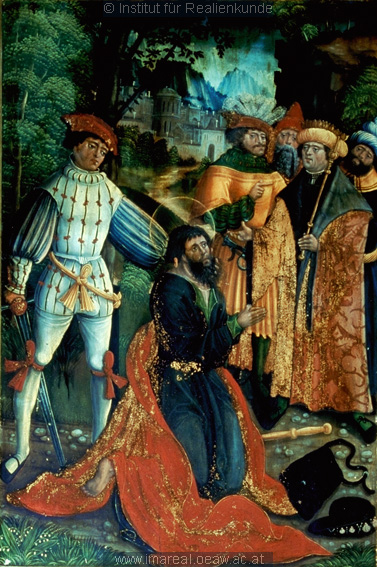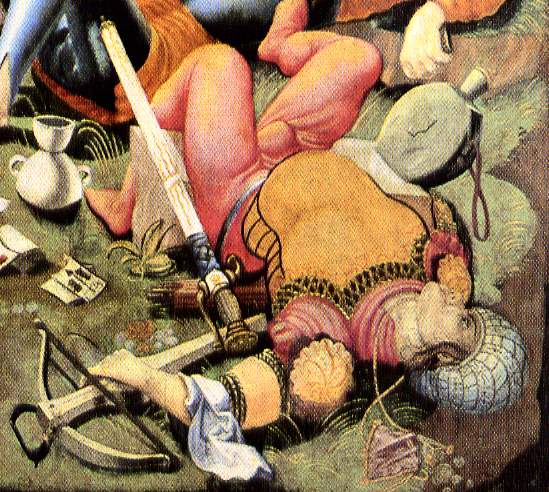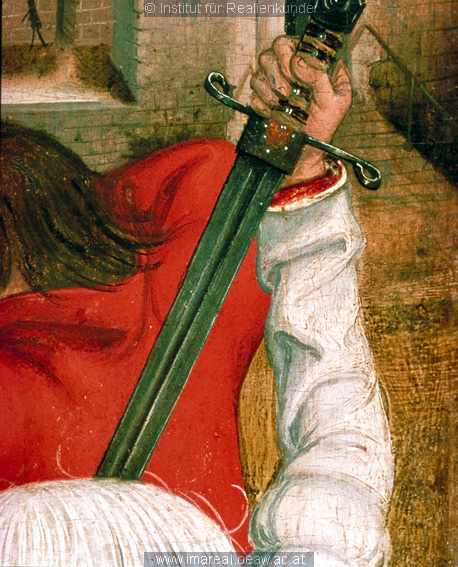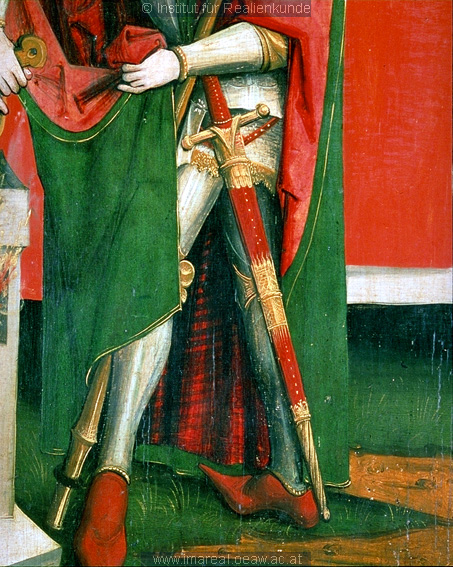Hey everybody,
I'm wondering what material other than leather could be used to cover a historically plausible scabbard for an early 16th century longsword... I like leather but it is not exactly very creative, every scabbard seems to be covered with it. I know linen/cloth was used on some early scabbards (before 1000 A.D.) but I've never heard of it being used later...
I'd appreciate all ideas!
Thanks
I've seen scabbards done in velvet and also in heavy brocade fabric, almost like curtain material. I've also seen cardboard and duct tape..... :lol: :lol: :lol: ...........McM
Thanks.
So velvet or brocade would be possible... good to know but not what I'm looking for. I want something sturdier that would be appropriate for a soldier, not a wealthy nobleman. Linen or wool would be out of the question?
So velvet or brocade would be possible... good to know but not what I'm looking for. I want something sturdier that would be appropriate for a soldier, not a wealthy nobleman. Linen or wool would be out of the question?
| Lukas MG wrote: |
| Thanks.
So velvet or brocade would be possible... good to know but not what I'm looking for. I want something sturdier that would be appropriate for a soldier, not a wealthy nobleman. Linen or wool would be out of the question? |
Linen and wool would probably be fine. Atypical, but there is no reason you could not use whatever covering you wanted in my opinion. I would probably avoid white, un-dyed stuff though as it'd tend to show any dirt very easily though.
View this thread: http://www.myArmoury.com/talk/viewtopic.php?t...hlight=red
For what it's worth:
• I see very few scabbards of any kind made to the aesthetic and quality standards of originals of that period. If you have one covered in leather and made to those standards, it will stand out by a mile.
• Leather was the historical choice for a reason. If you want something appropriate for a soldier, use leather. That doesn't limit you to black. German/Austrian scabbards of the period might be red, black or brown, often with decorated chappe. Painting is not unheard of. Finer examples might have extensive tooling. Suspensions took a variety of forms that leave room for decoration with tooling and gilt hardware. Light/short swords were sometimes suspended by knotting a bright fabric sash around them. There's lots of place for color, but leather is the historical standard for a soldier's scabbard.
For what it's worth:
• I see very few scabbards of any kind made to the aesthetic and quality standards of originals of that period. If you have one covered in leather and made to those standards, it will stand out by a mile.
• Leather was the historical choice for a reason. If you want something appropriate for a soldier, use leather. That doesn't limit you to black. German/Austrian scabbards of the period might be red, black or brown, often with decorated chappe. Painting is not unheard of. Finer examples might have extensive tooling. Suspensions took a variety of forms that leave room for decoration with tooling and gilt hardware. Light/short swords were sometimes suspended by knotting a bright fabric sash around them. There's lots of place for color, but leather is the historical standard for a soldier's scabbard.
Last edited by Sean Flynt on Mon 14 Jul, 2014 12:31 pm; edited 1 time in total
Some examples:
 Attachment: 175.71 KB
Attachment: 175.71 KB

 Attachment: 71.39 KB
Attachment: 71.39 KB

 Attachment: 193.99 KB
Attachment: 193.99 KB

 Attachment: 197.86 KB
Attachment: 197.86 KB





Thanks. I'm still tempted to chose linen but leather seems to be the way to go...
I don't necessarily want to do a very intricate, highly decorated scabbard. Wouldn't really fit with the sword or the intended kit, a swabian Landsknecht in 1523. While Landsknechts certainly were a colorful bunch, their weapons were probably more practical looking.
I don't necessarily want to do a very intricate, highly decorated scabbard. Wouldn't really fit with the sword or the intended kit, a swabian Landsknecht in 1523. While Landsknechts certainly were a colorful bunch, their weapons were probably more practical looking.
| Lukas MG wrote: |
| Thanks. I'm still tempted to chose linen but leather seems to be the way to go...
I don't necessarily want to do a very intricate, highly decorated scabbard. Wouldn't really fit with the sword or the intended kit, a swabian Landsknecht in 1523. While Landsknechts certainly were a colorful bunch, their weapons were probably more practical looking. |
I would advice against linen, and suggest a nice wool fabric, if you go down the fabric route. And the reason is the same as why linen is used for underwear and outer garments generally made of wool. Linen is highly water-absorbant, and wool is water-repellant. With a linen cover you would transport moisture into the wood core. A well stamped worsted wool woul on the other hand keep water away just as good as leather would.
Good point!! Thanks. I just wish there was at least one original scabbard with a wool cover...
Ok, I've pretty much decided on brown leather. Just can't justify using wool with no evidence to back it up.
Right now I'm looking at risers and chapes. A longitudinal riser is def. the way to go but I'm torn about the shape... in Dürer's work you often see VERY long chapes. More intriguing to me are the very small round shapes seen occasionally in other period art work: http://www.myArmoury.com/talk/files/1512_190_164.jpg
I doubt there's a surviving original so as the next best thing: Does anybody have a pic of a replica chape? Or any useful input regarding this type of chape? Can't make out any structural details in period art... I assume it's similar to earlier chapes? http://www.dietraumschmiede.de/zubeh/spathascheiderot.jpg
Right now I'm looking at risers and chapes. A longitudinal riser is def. the way to go but I'm torn about the shape... in Dürer's work you often see VERY long chapes. More intriguing to me are the very small round shapes seen occasionally in other period art work: http://www.myArmoury.com/talk/files/1512_190_164.jpg
I doubt there's a surviving original so as the next best thing: Does anybody have a pic of a replica chape? Or any useful input regarding this type of chape? Can't make out any structural details in period art... I assume it's similar to earlier chapes? http://www.dietraumschmiede.de/zubeh/spathascheiderot.jpg
For a traditional katzbalger chape check out Tod's Foundry
http://www.todsstuff.co.uk/todsfoundry/scabbard-fittings.htm
http://www.todsstuff.co.uk/todsfoundry/scabbard-fittings.htm
There is one example, I can think of earlier than your time period… but may be of interest given the topic thread... in the National Museum of Ireland, Belfast
It is a complete scabbard, in wonderful condition, dated to the 14th century.. The scabbard is wood, covered in a light colour linen, with a dark linen design at the throat. The belt has been removed but its imprint remains. There is a chappe made of leather, the edges have been skived and butted together seamlessly, the chappe is glued to the end of the scabbard.
I cannot post photos of the scabbard, as they are for academic research, and I am legally not allowed to share them.
I can't find it online, but emailing Dr Jim McGreevy, or another person at the National Museum Belfast to send photos/information.
Best,
Hadrian
It is a complete scabbard, in wonderful condition, dated to the 14th century.. The scabbard is wood, covered in a light colour linen, with a dark linen design at the throat. The belt has been removed but its imprint remains. There is a chappe made of leather, the edges have been skived and butted together seamlessly, the chappe is glued to the end of the scabbard.
I cannot post photos of the scabbard, as they are for academic research, and I am legally not allowed to share them.
I can't find it online, but emailing Dr Jim McGreevy, or another person at the National Museum Belfast to send photos/information.
Best,
Hadrian
Page 1 of 1
You cannot post new topics in this forumYou cannot reply to topics in this forum
You cannot edit your posts in this forum
You cannot delete your posts in this forum
You cannot vote in polls in this forum
You cannot attach files in this forum
You can download files in this forum
All contents © Copyright 2003-2006 myArmoury.com — All rights reserved
Discussion forums powered by phpBB © The phpBB Group
Switch to the Full-featured Version of the forum
Discussion forums powered by phpBB © The phpBB Group
Switch to the Full-featured Version of the forum